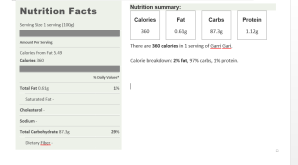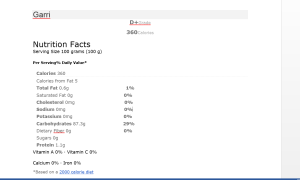Thanks to everyone who liked, commented and shared my previous post about Garri. I received some feedback from people who were concerned about the calorie content they see online for Garri, which at 300 calories per 100 g was way too high.
Now those of you who know me know that I’m not so much of a ‘calorie counter’. This is because a calorie is the amount of potential energy (not fat) we get from a given food and given that energy needs will differ from individual to individual (depending on stage of life, location (hot or cold climate), state of health etc) guideline information needs to be used carefully. However, I have decided to do this post for the benefit of those who might be interested in knowing more about calorie contents of foods. 🙂
The calorie information found online about Garri can be misleading, this is because most website make no distinction as to the type of Garri which is very important. If we do a quick search on the internet what you might find is information like this one which just says Garri.
Source: (https://www.fatsecret.com/Diary.aspx?pa=fjrd&rid=73594)
However, after a bit of research, I found this website which differentiate between different grades of Garri.
Source: http://www.caloriecount.com/calories-Garri-i332701

Source: http://www.caloriecount.com/calories-adom-foods-gari-flour-i260439
Looking at the two tables we see a significant difference in the calorie content. The grade C one has 155 calories per 100g while grade D has 360 calories. Another difference is the carbohydrate content which is 87.3 g for grace D and 27 g for grace C. Also the vitamin C is 35% for grade C and 0% for grade D while fibre content is 6% for grade C and 0% for Grade D.
The website doesn’t say what Grade D or C is but if the principle that fermentation reduces carbohydrate count is true (which I believe it is) then I believe that the grade C is likely to be a variant of Garri that has undergone a longer fermentation process similar to that of Ijebu Garri.
Also fermentation improves the ascorbic acid/vitamin C content of foods and given the sour taste of Ijebu Garri (which suggest the presence of ascorbic acid/vitamin C) then I believe grade C is likely to be a variant similar to Ijebu Garri.
Body Ecology states “fermented vegetables give you a one-shot double whammy: vitamin C, and microflora which help you better absorb not just vitamin C, but all the nutrients your body needs!”
This statement is in line with a research carried out by C.I. Owuamanam et al (2010) and titled ‘Nutritional Evaluation of Garri Diets from Varying Fermentation Time Using Animal Model’. The research involved feeding groups of rats a diet of Garri which was fermented for 0h, 24h, 48h and 72h. The result showed that level of dietary cyanide reduced significantly the longer the fermentation time. As a result nutrient absorption was optimised and highest with rats fed on the 72h fermented Garri.
Ijebu Garri is left to ferment for at least 7 days and sometimes more which means that the dietary cyanide is reduced beyond the results of this research. This is in addition to lowering carbohydrate count, optimising vitamin C content as well as probiotic and prebiotic benefits.
Another issue I find interesting and which I have been looking into recently is a comparative analysis of the calorie content in different swallows compared to Ijebu Garri. Here I have just two such examples but hope to do a broader research in the future. (watch this space) 🙂
First let us look at Wheat Flour, this has 372 calories, which is 140% more calories than Grade C Garri (Ijebu Garri)
Next we have semolina which has 340 calories per 100g, which is 119% higher calorie content.
Now, it can be argued that these foods are higher in other nutrients such as potassium or Protein. However Garri (Eba) is seldom eaten on its own, I believe the rich array of soups that accompany it more than make up for what it lacks in terms of nutrients, without the added calories.
So, am I saying don’t eat wheat, semolina or other types of Garri? Not at all, the aim here is for us to make informed decisions but also to come to appreciate the many benefits of our indigenous diet. I always say ‘Eat from and for your location’, the diet that has helped to sustain our ancestors cannot all of a sudden become redundant. It is our heritage and we must protect it. 🙂
Remember all things in moderation, the fact that a food is healthy doesn’t mean we should over indulge. 🙂
Another point I forgot to mention is that I have for many years now used Ijebu Garri as a cure for simple diarrhea. I was pleased when my ‘Doctor’ friend after reading my previous post confirmed that she recommends it to patients “after a bout of diarrhea to restore microbial balance” 🙂
Please do consult your health provider/dietician/nutritionist before making changes to your diet.
If you have found this useful, don’t forget to like, comment and share you might be saving a life! 🙂




Raaaa!!!!! Omo iye mi, wo se o!
LikeLiked by 1 person
Logs it into fitnesspal
LikeLiked by 1 person
I found this post very very helpful. Looking foward to the outcome of more of your research.
You just solved my immediate problem with this post.
Tnks
LikeLike
I appreciate ur research work on our local food “Garri”. Pls what will be the effect of adding other nutrients like vitamin C, A, or potassium to upgrade the nutritional value of Garri.
LikeLike
Ijebu Garri already has some vitamin c (ascorbic acid) present in it and personally given that garri is often eaten with a wide vegetable based soups I would say it is nutritious on its own.
LikeLike
Thank you, this is really informative and helpful.
LikeLike
You are welcome dear. Thanks for stopping by. 😊😊
LikeLike
Thank you. Our fore father ate garri every day and lived till they were very old. generally, they had a very physical lifestyle sha. I read your post on ijebu garriand i have decided to start taking it as my regular swallow. fufu and pounded yam will be for special occassion.
LikeLike
Thanks for this. Really helpful.
LikeLike